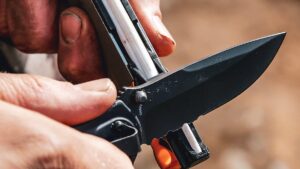Last summer our family had a reunion in Alaska, venturing from forest to mountains to sea and staying up late into the subarctic evenings. The vibe was mellow; the Alaskan Amber went down smoothly. But something was missing. We’re all music lovers—my 20-something kids even tolerate some of the tunes I like—and I didn’t bring a Bluetooth speaker.
Three weeks of moving around, hiking and biking here, fishing and kayaking there, fighting off mosquitoes everywhere, meant packing a variety of clothes and gear, so I wanted to save on weight. But the trade-off for being able to fire up a one- or two-pound wireless speaker each night would’ve been well worth it.
Fortunately for all of us, Bluetooth speakers are sounding louder and better than ever. There are more options for weatherproof models that you can drop in the mud, and we’re seeing more features like USB-C output (for charging your phone so the speaker has music to play, something found on all the models here), fast charging, and “true stereo” that you can achieve by pairing two units at once—not to mention new and clever ways to enhance the acoustics.
On your next outing, plan accordingly: International flight? A one-pound speaker means nothing when you’re trying to stay under the 50-pound limit, and rescues a movie night at the hotel when you’re in “recovery.” Canoe-packing trip? A five-pounder with IP67 water resistance. National park road trip: Bring the monster (but respect your fellow campers). As for day hikes on a trail with other hikers: Please don’t strap a speaker on your back and play Matchbox Twenty. That’s what we came here to get away from.
At a Glance
Best All-Around: House of Marley Get Together 2 XL ($299)
Most Rugged: Turtlebox Gen 2 ($399)
Best for Home or Tame Travels: Morel Biggie ($299)
Best For Audiophiles: Bose SoundLink Max ($399)
Best For Travel: Klipsch Nashville ($149)
Best Value: Tribit XSound Plus 2 ($70)
Also Recommended
How to Choose
How We Test
Meet Our Lead Testers
All gear in this guide was tested by multiple reviewers. When you buy through our links, we may earn an affiliate commission. This supports our mission to get more people active and outside. Learn more.
(Photo: Courtesy House of Marley)
Best All-Around
House of Marley Get Together 2 XL
$299 at Amazon $400 at House of Marley
“It feels like there’s a pretty fun party lurking not too far beneath the surface here,” one of our testers said, and indeed the Get Together 2XL is one of the loudest and liveliest Bluetooth speakers you’re ever likely to hear. Weighing in at 12.65 pounds and almost 18 inches from end to end, it’s not one you’ll be dangling from a pack on a day hike, but, being IP65 water- and dust-resistant, it does perform in the outdoors, whether that means tailgating, pool parties, or campgrounds. “It delivered one of my go-to punk torture tracks, ‘London Calling,’ with flying colors at top volume,” said another tester.
True to House of Marley’s heritage, the 60-watt 2XL has a sustainability story, with an attractive bamboo face and fabric cladding made from recycled plastic, reclaimed cotton, and hemp, and even the insides use recycled materials. (One tester pointed out that the eco-story is slightly belied by the inclusion of five power adapters for use abroad—for a speaker we’d scarcely think of bringing on an international flight.) Though it doesn’t come with a strap, as one tester noted, “in the absence of a handle you could string a hemp rope between the two built-in strap loops and keep the natural aesthetic alive.” The speaker plays for 20 hours on a single charge and can switch between three different sound modes: signature, bass boost, and acoustic. “Its size and sonic muscle is a fun throwback to boomboxes of yore,” one tester said.
(Photo: Courtesy Turtlebox)
Most Rugged
Turtlebox Gen 2
$399 at Amazon $399 at Turtlebox
Like Pelican and Otter, Turtlebox thinks in terms of durability that will see you through any terrain on earth, if not other planets. Case in point: The company’s website claims that they were able to park a six-ton monster truck on this speaker, to no ill effect. Encased in super-hard plastic and completely waterproof (even floatable), the Gen 2 has quickly garnered a following among fishermen and watersports enthusiasts for more than being tough. The 120-decibel speaker is “both incredibly loud and impressively refined,” one tester observed. Indeed, our team was hard-pressed to find many differences in audio quality between the Turtlebox 2 and the other top scorers in this year’s test. The unit also plays for 25 hours at lower volumes and about six hours at max volume, such as you’d need for a big party.
During LCD Soundsystem’s “Tribulations,” the bass tones flowed smooth as silk and distortion-free, thanks to the 6-by-9-inch woofer, and, to our surprise, the high and midrange sounds also came across with great clarity. With five color options and an ideal form factor—a lunchbox-size 9.5-pound boombox with a hard nylon handle coated in rubber, plus rubber bumpers on the undercarriage—the Turtlebox Gen 2 gets just about everything right, and its fairly high price tag is less scary when you consider its durability.
(Photo: Courtesy Morel)
Best For Home And Tame Travel
Morel Biggie
$299 at Morel
If the Turtlebox is the speaker that wears camo and hip waders, the Morel Biggie is in a well-tailored suit. But it, too, sounds pristine. The Biggie is the 7-by-7-inch, 5.8-pound smaller sibling to the company’s 12-by-12-inch, 16-pound modular Högtalare bookshelf speaker, which was designed in conjunction with Ikea to fit inside its bookcases. The Biggie retains those sleek looks and gets a fat faux-leather handle that invites you to pick it up and take it on a road trip. While travel and patio use are certainly within its capabilities, it does not offer any water resistance (and the speaker cover is held on with magnets, which is cool but allows it to pop off easily during transport). It stays connected across an impressive 165-foot range, so whether you’re carting it to the backyard to do chores or playing it in your Airbnb, you’ll appreciate the Biggie’s outstanding sound.
The well-priced speaker has a four-inch woofer and one-inch tweeter and employs digital signal processing (DSP), which, as the company describes it, “continually adjusts according to the set listening volume to create a well-balanced and natural sound free from distortion and coloration.” Battery life is a respectable 20 hours at 50 percent volume, and it has a quick-charge feature that can come in handy when you’re on the move. The only problem with the nine color options is that you won’t know which one to choose. “With one of the most discreet profiles I’ve seen in a speaker,” one tester enthused, “it causes a double take every time I realize how loud and clear it sounds.”
(Photo: Courtesy Bose)
Best For Audiophiles
Bose SoundLink Max
$399 at Amazon $399 at Bose
For those who were wowed by Bose’s 1.3-pound SoundLink Flex (our 2022 Editor’s Choice winner), this larger and far more powerful 4.9-pound edition of the SoundLink will be true love. It punches above its weight, with rich bass and perfect balance in the higher registers. While the addition of a rubber-coated rope handle is both convenient and cute, the sticking-to-basics features from this classic brand made it a bit less fun than other party-ready units in this test. Where Bose beats them, though, is with more subtle orchestral and ambient tracks. Max Richter’s The New Four Seasons came through with a dynamism and presence that was a notch above.
Battery life is 20 hours, range is a passable 30 feet, and Bose’s app is more versatile than those that accompany most speakers, with EQ settings to suit your tastes and listening environment. IP67 water and dust resistance means it’s fine being dropped in the pool for up to 30 minutes. The SoundLink Max does cost a lot for its size, but for those among us who like to just sit and focus on great music, it may be the most ideal—and ideally sized—portable speaker to date.
(Photo: Courtesy Klipsch)
Best For Travel
Klipsch Nashville
$149 at Amazon $149 at Klipsch
Ten years ago, it would’ve been inconceivable to hear sound this deep and loud coming from a speaker so small. Such are the advances of science. Klipsch’s Nashville is the Goldilocks among a new trio of IP67 water- and dust-resistant speakers from the brand (alongside the larger Detroit and the smaller Austin). All of them sound great, but the Nashville won us over because it over-delivers for its size, a mere 2.4 pounds and seven inches wide. A pair of 2.25-inch full-range drivers—one on the front and another on the back—create what the company calls 360-degree sound, so it works nicely in the center of a room as opposed to a bookshelf.
The tough build—with cushy rubber cladding all around—instills confidence in its durability, and its 24-hour battery life makes it even better for carrying through remote places without power. The Nashville has a 40-foot range and can be wirelessly linked together with up to 10 other compatable Klipsch units. We also like the built-in mic, which allows it to work as a speakerphone, courteously pausing your music on its own. “The cool retro looks don’t prepare you for how thoroughly modern this speaker sounds,” one tester said.
(Photo: Courtesy Tribit)
Best Value
Tribit XSound Plus 2
$70 at Amazon $70 at Tribit
About 33 percent smaller than the Klipsch Nashville, Tribit’s 1.76-pound XSound Plus 2 is another travel-friendly speaker you can throw in your duffel without a second thought. It offers impressive technology for its price, including DSP, 24 hours of battery life, and a terrific 150-foot range. While it has surprisingly strong bass, it does tend to get distorted at higher volumes—though given its size, we wouldn’t expect anything more. The XSound Plus 2 is IPX7-rated, making it fine with direct sprays of water or a quick dunk.
The looks are clean, and controls are simple to use, including a True Wireless Stereo button that joins two Tribits together (a reasonable $140 investment), allowing them to play in stereo. According to one tester, “moderate approval turned to something like love when I heard these as a stereo pair—the two units sounded terrific together, with good separation, a wide soundstage, and a big leap in punch.” The Tribit app helps you get more out of the unit(s): equalizers for bass boosting, rock, jazz, audiobooks, and “MaxSound traditional” do a great job of tailoring the sound to suit your tracks and help reduce distortion.
Also Recommended
These speakers didn’t quite make our top picks, but we still think they’re worth a look if they match your needs.
(Photo: Courtesy Soundboks)
Soundboks Go
$699 at Amazon $699 at Soundboks
We’re fans of this very loud, tough-built 20-pound beast. It’s a big piece of equipment (and a big investment) that is best suited to big outdoor bashes, with a battery life of 40 hours at mid-volume, a useful carrying strap, and an excellent app with equalizers you can customize or use the presets for indoor use, bass boosting, and more.
(Photo: Courtesy Ultimate Ears)
Ultimate Ears Epicboom
$290 at Amazon $300 at Ultimate Ears
UE’s “Boom” series of speakers are easy to connect, aesthetically interesting, and reliable. The midsize, 4.36-pound Epicboom is no exception. With IP67 protection, well-rounded audio, bass you can really shake your hips to, and a nice array of colors, it’s one of the more fun and versatile party speakers out there.
(Photo: Courtesy Skullcandy)
Skullcandy Terrain
$60 at REI $60 at Amazon
Weighing in at one pound, this toss-in-your-pack unit is a nice pick for far-flung adventures, or simply strapping on your handlebars. It doesn’t have the oomph of some others its size, but it certainly puts the speakers on any smartphone or laptop to shame, for a value price.
How to Choose
When shopping for a new Bluetooth speaker, first consider whether you’ll be using it indoors, outdoors, or both. Check its IP (ingress protection) rating to get an idea of how much water and dust resistance it offers; these are typically reliable. Next, think about how much you’ll be carrying it around—between house and backyard, say, or moving from campsite to campsite—and whether you’ll be on foot (carrying a pack or duffel, or not) or on wheels. Then consider what makes sense in terms of weight and dimensions. As a general rule, the heavier a speaker is, the more volume you’ll get out of it, but playing it loud isn’t always a necessity—some of you will be entertaining large groups, but others will just be setting it up for mellow creekside cocktail-hour listening with your partner.
If you’re someone who moves around a lot, a speaker with long battery life might also make a difference. These days most new models will play for a good 10 hours or more even at high volume, but some are longer-lasting than others, as detailed in the models reviewed here. Finally, more and more models offer “true stereo” linking, where two or more speakers can be paired to play at once, but in stereo; this makes smaller models with this option a little more attractive than before, because if you later decide to invest more, you can give your soundscape an appreciable boost.
How We Test Audio Equipment
Hours of Podcasts Consumed During Travel: 28
Yoga Sessions: 7
Number of Miles Run While Testing Ear Buds: 255
Number of Dogs Walked: 8
Coldest Temp: –3, Anchorage, Alaska
Warmest Temp: 90, Santa Fe, New Mexico
Most Remote Testing Location: Antarctica
Most Listened-To Tracks: Japanese Breakfast: “Paprika,” Bob Marley and the Wailers: “Natural Mystic,” Wet Leg: “Chaise Longue,” Danger Mouse and Black Thought, feat. MF Doom: “Belize,” Kelly Lee Owens: “Moebius,” Brian Eno: “Discreet Music,” Sam Fender: “Hypersonic Missiles”
The first thing we do with any Bluetooth speakers is attempt to pair them with our phones without consulting the user manual: the quicker, more intuitive, and easier the sync, the more points scored. Then we put them through hours of testing doing the kinds of things Outside readers do—soaking in remote hot springs, inviting friends over for outdoor dance parties, playing audiobooks while riding a bike, etc.
Our team turns in reports on each product tested, providing a score of 1 to 10 for five different measures: sound quality, pairing and connectivity, fit and comfort, rain and drop protection, and user friendliness. Scores are averaged, with more weight given to sound quality and (knowing our audience) how well they stand up to the elements. Note: Battery life estimates in these reviews are based on manufacturer specs; it’s difficult to confirm those numbers, given the time involved and variances among user habits (different volumes, different uses, different functions enabled). Actual results may be 10 to 20 percent lower, judging from averages experienced in general testing.
Meet Our Lead Tester
Will Palmer has been testing gear for 20 years for Outside, where he was managing editor and copy chief for nine years. Based in Santa Fe, he has been a runner since 1984, and while the mile counts have decreased over the years, he’s kept motivated to head out the door on the hottest, coldest, and wettest days by the opportunity to test the best new products—and to commune with the junipers and piñons.
The post The Best Bluetooth Speakers for Outdoor Adventures appeared first on Outside Online.
















